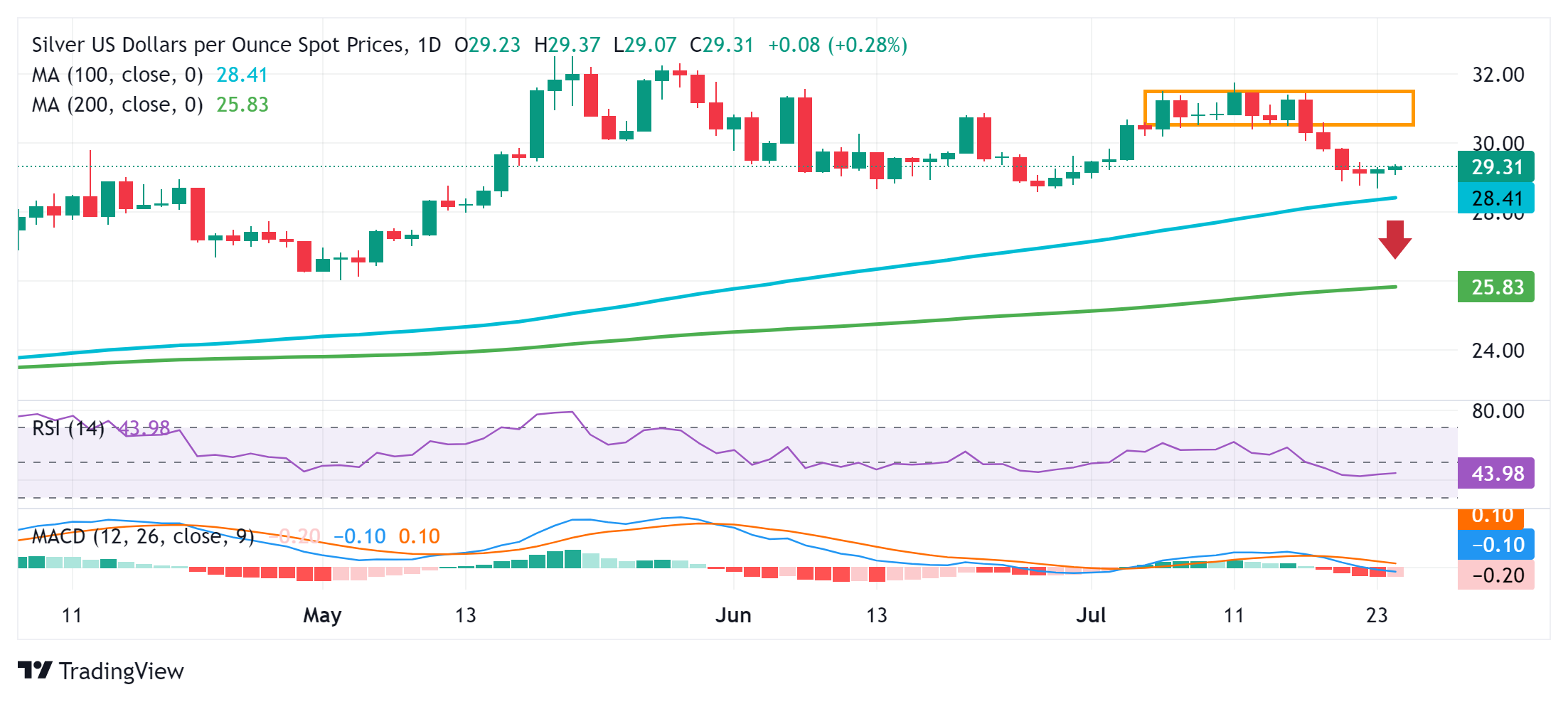- Analytics
- News and Tools
- Market News
- Silver Price Analysis: XAG/USD climbs closer to weekly top, upside potential seems limited
Silver Price Analysis: XAG/USD climbs closer to weekly top, upside potential seems limited
- Silver gains some positive traction for the second successive day on Wednesday.
- The technical setup warrants some caution before positioning for further gains.
- A break below the 100-day SMA support will be seen as a fresh trigger for bears.
Silver (XAG/USD) ticks higher during the Asian session on Wednesday and looks to build on the previous day's modest bounce from the $28.70-$28.65 region, or a nearly one-month low. The white metal, however, remains below the weekly peak touched on Monday and currently trades around the $29.35 area, up over 0.30% for the day.
From a technical perspective, the breakdown through a short-term trading range was seen as a fresh trigger for bearish traders. Moreover, oscillators on the daily chart have just started gaining negative traction and suggest that the path of least resistance for the XAG/USD is to the downside. That said, the overnight bounce from the vicinity of the $28.60-$28.55 support zone, or the June monthly swing low, and the subsequent move-up warrants some caution.
In the meantime, momentum beyond the $29.40-$29.45 area, or the weekly peak, is likely to confront some hurdle near the $29.80 region. This is closely followed by the $30.00 psychological mark, above which a bout of a short-covering move could lift the XAG/USD back towards the $30.35-$30.40 trading range support breakpoint, now turned resistance. The momentum could extend further and allow the bulls to reclaim the $31.00 round-figure mark.
A sustained strength beyond the latter will negate any near-term negative bias and pave the way for a move towards the $31.40 supply zone. Some follow-through buying beyond the monthly peak, around the $31.80 area, has the potential to lift the XAG/USD towards the $32.00 mark en route to the YTD peak, near the mid-$32.00s touched in May.
On the flip side, weakness below the $29.00 mark might continue to find decent support near the $28.60-$28.55 region. The said area now coincides with the 100-day Simple Moving Average (SMA) and should act as a key pivotal point. A convincing break below would make the XAG/USD vulnerable to accelerate the slide further below the $28.00 round figure, towards testing the next relevant support near the $27.50-$27.40 horizontal resistance breakpoint.
Silver daily chart
Silver FAQs
Silver is a precious metal highly traded among investors. It has been historically used as a store of value and a medium of exchange. Although less popular than Gold, traders may turn to Silver to diversify their investment portfolio, for its intrinsic value or as a potential hedge during high-inflation periods. Investors can buy physical Silver, in coins or in bars, or trade it through vehicles such as Exchange Traded Funds, which track its price on international markets.
Silver prices can move due to a wide range of factors. Geopolitical instability or fears of a deep recession can make Silver price escalate due to its safe-haven status, although to a lesser extent than Gold's. As a yieldless asset, Silver tends to rise with lower interest rates. Its moves also depend on how the US Dollar (USD) behaves as the asset is priced in dollars (XAG/USD). A strong Dollar tends to keep the price of Silver at bay, whereas a weaker Dollar is likely to propel prices up. Other factors such as investment demand, mining supply – Silver is much more abundant than Gold – and recycling rates can also affect prices.
Silver is widely used in industry, particularly in sectors such as electronics or solar energy, as it has one of the highest electric conductivity of all metals – more than Copper and Gold. A surge in demand can increase prices, while a decline tends to lower them. Dynamics in the US, Chinese and Indian economies can also contribute to price swings: for the US and particularly China, their big industrial sectors use Silver in various processes; in India, consumers’ demand for the precious metal for jewellery also plays a key role in setting prices.
Silver prices tend to follow Gold's moves. When Gold prices rise, Silver typically follows suit, as their status as safe-haven assets is similar. The Gold/Silver ratio, which shows the number of ounces of Silver needed to equal the value of one ounce of Gold, may help to determine the relative valuation between both metals. Some investors may consider a high ratio as an indicator that Silver is undervalued, or Gold is overvalued. On the contrary, a low ratio might suggest that Gold is undervalued relative to Silver.
© 2000-2025. All rights reserved.
This site is managed by Teletrade D.J. LLC 2351 LLC 2022 (Euro House, Richmond Hill Road, Kingstown, VC0100, St. Vincent and the Grenadines).
The information on this website is for informational purposes only and does not constitute any investment advice.
The company does not serve or provide services to customers who are residents of the US, Canada, Iran, The Democratic People's Republic of Korea, Yemen and FATF blacklisted countries.
Making transactions on financial markets with marginal financial instruments opens up wide possibilities and allows investors who are willing to take risks to earn high profits, carrying a potentially high risk of losses at the same time. Therefore you should responsibly approach the issue of choosing the appropriate investment strategy, taking the available resources into account, before starting trading.
Use of the information: full or partial use of materials from this website must always be referenced to TeleTrade as the source of information. Use of the materials on the Internet must be accompanied by a hyperlink to teletrade.org. Automatic import of materials and information from this website is prohibited.
Please contact our PR department if you have any questions or need assistance at pr@teletrade.global.
















